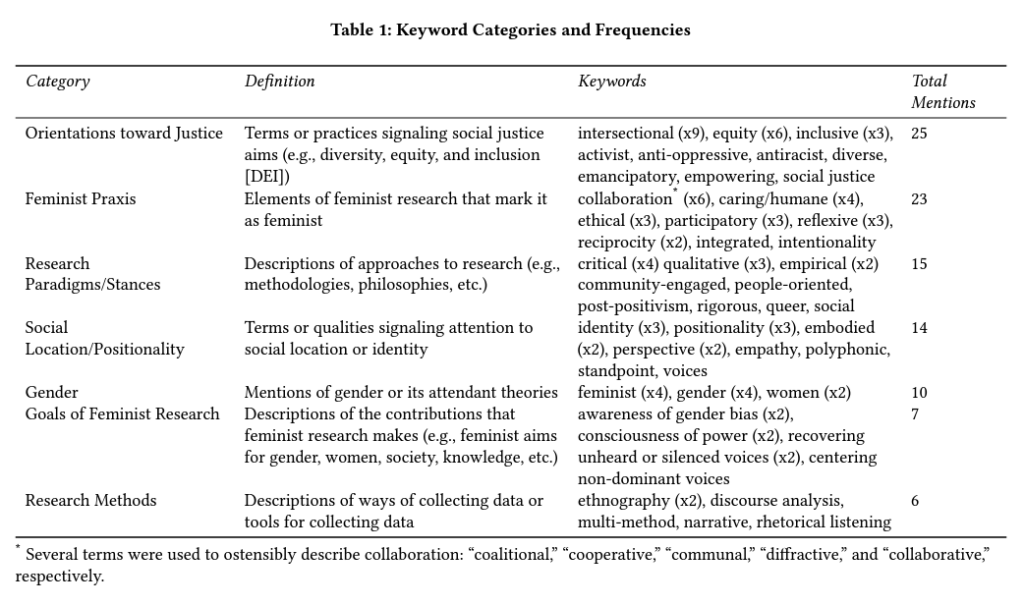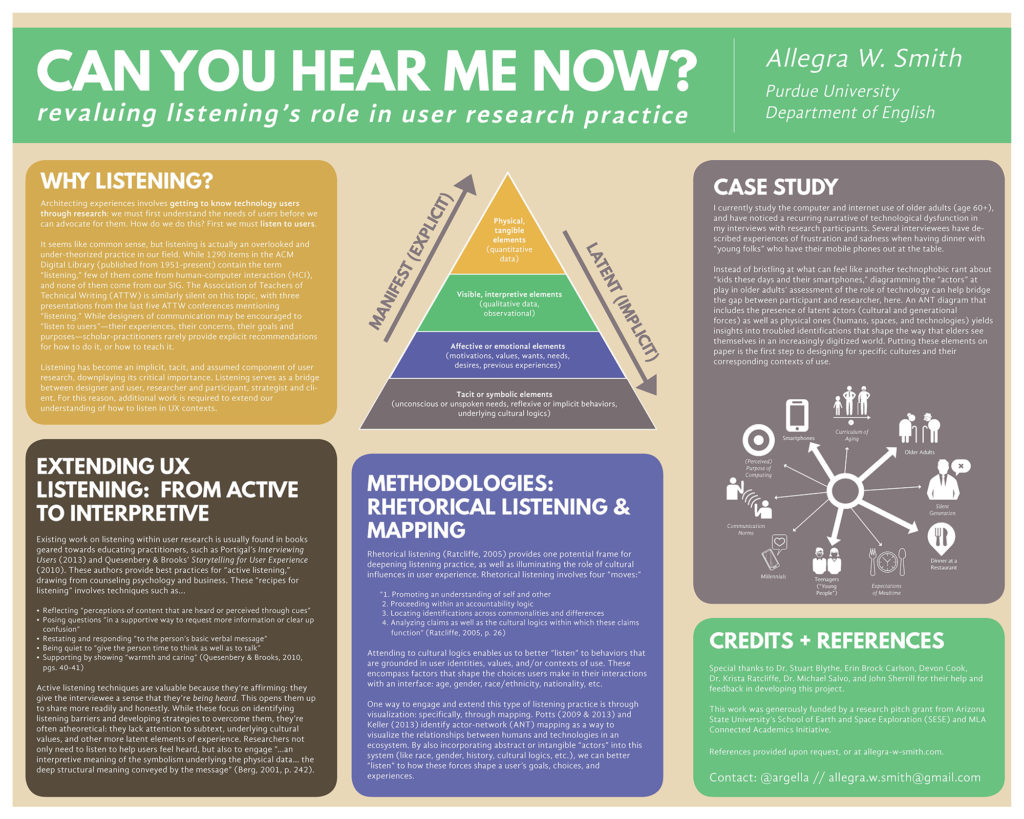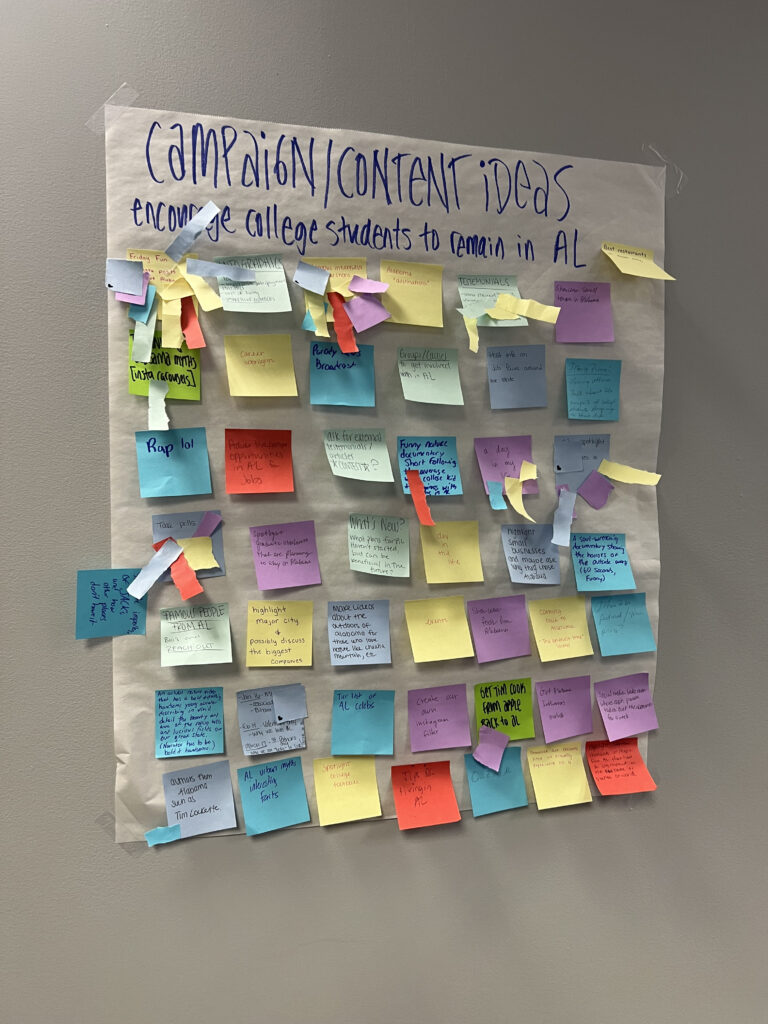These represent a selection of recent and noteworthy papers. For a complete listing, see my CV or Google Scholar page.
17 students, 1 project:
Design thinking pedagogy for a large-scale UX community/classroom partnership
Allegra W. Smith and Courtney. D. Ray (2024)
This teaching case (coauthored with a former undergraduate student mentee) applies design thinking to a large-scale client project in a technical and professional communication (TPC) class. Using the 5-step design thinking process (“empathize, define, ideate, prototype, test”) over 8 weeks, the students in an upper-division TPC course developed social media content and strategy for a statewide public relations campaign. The two authors, the instructing faculty and a senior student who served as project manager, illuminate how iterative design thinking, as a UX pedagogical practice, can help students set boundaries around ill-defined problems; mirror workplace collaboration to contribute to professional development; and build a toolkit for exercising agency and creativity as researchers, writers, and designers.
Full issue available through the Communication Design Quarterly archive.
Designing feminist methodologies:
Foregrounding gender, positionality, and justice in communication design research
Allegra W. Smith (2023)
This paper was shortlisted for the best paper prize at the 2023 ACM-SIGDOC conference and received an honorable mention citation. While several studies from ACM-SIGDOC have used feminist research methodology as a frame, there exists no clear definition of what constitutes feminist methodology for the organization’s constituencies, or how it can be applied across its disciplines (i.e., communication design and technical/professional communication [TPC]). To generate a baseline understanding of the field’s understanding of feminist research methodologies, I conducted a survey of TPC and communication design scholars, which asked four questions about how they defined these types of research frameworks, and whether they used such frameworks in their own scholarship. I report the results of this survey and use participants’ responses, alongside previously published scholarship in the field, to create a taxonomy of feminist methodological values that can guide research in TPC and communication design. I conclude with a description of practical tactics that researchers can use to align their projects with these values and integrate feminist methodology into their work.
Proceedings paper available open access through the ACM Digital Library.

Everyone is always aging:
Glocalizing digital experiences by considering the oldest cohort of users
Allegra W. Smith (2022)
Older adults (aged 65+) represent an under-explored group in technical communication, despite rapid population aging. Designing for older age cohorts holds potential for “glocalization”—integrating the local and the global—through attending to the needs of a specific user community while benefiting all users through interventions that prioritize usability, accessibility, and generational cultures.
Using structured task analysis methods, I investigated the steps and decisions that six adults aged 75+ took to accomplish five increasingly difficult tasks. Though participants were easily able to access the internet and find a news story online, they faced difficulties when attempting to modify the homepage on
their browser, use mapping tools to determine the distance between two locations, and identify a government document answering a question about income taxes. These findings point to four key considerations when designing for older age cohorts: user customization and personalization, information literacy, deceptive patterns, and mismatched mental models stemming from gaps between declarative and procedural knowledge. Addressing these needs through targeted design, documentation, and
education can help the oldest user group to realize their technological goals.
Article available from Technical Communication (Volume 69, Issue 4).
User experience design for older adults:
Experience architecture and methodology for users aged 60+

Allegra W. Smith (2019)
This paper describes a study that combined interview and observation methods to explore the user experiences of 23 users aged 70+. Interviews involved questions about how and when users learned to use computers and the internet, as well as their usual online activities and difficulties completing those activities. Observations involved two sessions for each user: first, a naturalistic observation where the researcher recorded the participant interacting with the computer(s) in their home, demonstrating their typical internet use; second, a structured task analysis where participants completed a series of increasingly complex operations online, including searching for information on a specific topic, using web mapping tools, and interacting with a government website. Participants followed a think-aloud protocol during both observations, explaining the steps that they were taking and sharing their thought process and feelings with the researcher. The rich qualitative data from this work provides insights into the needs of this population in four specific areas—physical, cognitive, educational, and cultural—as well as design strategies for addressing those needs.
Available for download from the ACM Digital Library.
“Can you hear me now?”:
Revaluing listening’s role in user research practice
Allegra W. Smith (2017)
Winning the Microsoft-sponsored Student Research Competition award at 2017’s ACM-SIGDOC conference, this project identifies listening as a component of user experience research that has been under-explored in both scholarly and practitioner literature. By combining rhetorical frameworks with existing UX best practices, I called for the revaluation of listening’s role in the data-gathering and analysis process, particularly when the researcher and participants operate from different cultural standpoints. I presented the poster alongside 12 other graduate students at the SIGDOC 2017 Conference in Halifax, Nova Scotia, Canada, before advancing to the final round of oral presentations in front of an audience of faculty, students, and industry professionals in the field of communication design.
Full poster available here; paper available here.

